
Cam Ranh Bay is a deep-water bay in Vietnam in Khánh Hòa Province. It is located at an inlet of the South China Sea situated on the southeastern coast of Vietnam, between Phan Rang and Nha Trang, approximately 290 kilometers northeast of Ho Chi Minh City.

U.S. Military Assistance Command, Vietnam (MACV) was a joint-service command of the United States Department of Defense.

Buckley Space Force Base is a United States Space Force base in Aurora, Colorado named after United States Army Air Service First Lieutenant John Harold Buckley. The base is run by Buckley Garrison, with major units including the U.S. Space Force's Space Delta 4, the Colorado Air National Guard's 140th Wing, the Denver Naval Operations Support Center, and the National Reconnaissance Office's Aerospace Data Facility-Colorado.
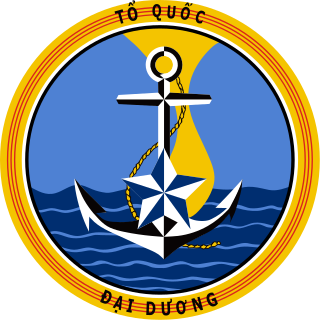
The Republic of Vietnam Navy was the naval branch of the South Vietnamese military, the official armed forces of the former Republic of Vietnam from 1955 to 1975. The early fleet consisted of boats from France. After 1955 and the transfer of the armed forces to Vietnamese control, the fleet was supplied from the United States. With American assistance, in 1972 the VNN became the largest Southeast Asian navy and the fourth largest navy in the world, just behind the Soviet Union, the United States and China, with 42,000 personnel, 672 amphibious ships and craft, 20 mine warfare vessels, 450 patrol craft, 56 service craft, and 242 junks. Other sources state that VNN was the ninth largest navy in the world. The Republic of Vietnam Navy was responsible for the protection of the country's national waters, islands, and interests of its maritime economy, as well as for the co-ordination of maritime police, customs service and the maritime border defence force.

The Indonesian Navy is the naval branch of the Indonesian National Armed Forces. It was founded on 10 September 1945 and has a role to patrol Indonesia's lengthy coastline, to enforce and patrol the territorial waters and Exclusive Economic Zone (EEZ) of Indonesia, to protect Indonesia's maritime strategic interests, to protect the islands surrounding Indonesia, and to defend against seaborne threats.
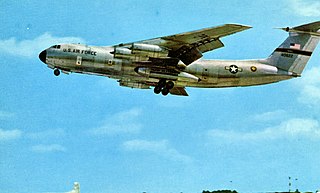
The Military Airlift Command (MAC) is an inactive United States Air Force major command (MAJCOM) that was headquartered at Scott Air Force Base, Illinois. Established on 1 January 1966, MAC was the primary strategic airlift organization of the Air Force until 1974, when Air Force tactical airlift units in the Tactical Air Command (TAC) were merged into MAC to create a unified airlift organization.

The 3rd Marine Logistics Group is the Logistics Combat Element (LCE) for III Marine Expeditionary Force currently headquartered on Camp Kinser, Marine Corps Base Smedley D. Butler, Okinawa, Japan. 3rd MLG provides combat service support (CSS) to III MEF units above the organic capability. CSS is the essential capabilities, functions, activities, and tasks necessary to sustain all elements of operating forces in theater at all levels of war. Combat service support includes, but is not limited, to supply, maintenance, transportation, general engineering, health services, and other services required by aviation and ground combat forces to permit those units to accomplish their missions.

The 1st Theater Sustainment Command is a major subordinate unit of US Army Central at Fort Knox, Kentucky.
Cam Ranh Air Force Base is located on Cam Ranh Bay in Khánh Hòa Province, Vietnam. It was one of several air bases built and used by the United States Air Force (USAF) during the Vietnam War.
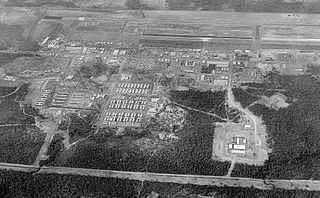
The Nakhon Phanom Royal Thai Navy Base (NKP), formerly Nakhon Phanom Royal Thai Air Force Base, is a Royal Thai Navy facility used for riverine patrols along the Mekong River. It is approximately 587 km northeast of Bangkok, 14.5 km west of Nakhon Phanom city in Nakhon Phanom Province in the northeastern region of Thailand, and 411 km from Hanoi in Vietnam. The Mekong River is NKP's border with Laos. The airfield at NKP is jointly used as a civilian airport.
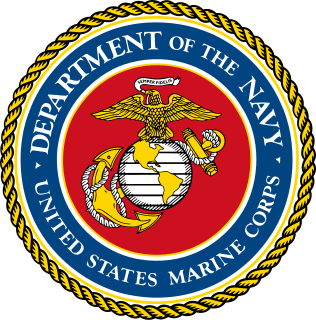
The United States Marine Corps is organized within the Department of the Navy, which is led by the Secretary of the Navy (SECNAV). The most senior Marine commissioned officer is the Commandant of the Marine Corps, responsible for organizing, recruiting, training, and equipping the Marine Corps so that it is ready for operation under the command of the unified combatant commanders. The Marine Corps is organized into four principal subdivisions: Headquarters Marine Corps, the Operating Forces, the Supporting Establishment, and the Marine Forces Reserve.

Helicopter Sea Combat Squadron EIGHT FIVE (HSC-85) is a United States Navy Reserve forces helicopter squadron (RESFORON) based out of Naval Air Station North Island in San Diego, California. The "FIREHAWKS" of HSC-85 are Reserve and Active Component Sailors who operate and maintain Sikorsky MH-60S Seahawk helicopters.
The 59th Quartermaster Company is a bulk petroleum company designed to provide semi-portable storage for 2.5 million US gallons (9,500 m3) of fuel and to provide distribution of fuel to military units within a specified geographic area while deployed overseas. Its secondary mission is to provide an armed military escort to military cargo and civilian trucks during overseas contingency operations. It is a U.S. Army Forces Command combat service support unit stationed at Fort Carson, Colorado under the command of the 68th Combat Sustainment Support Battalion. The 59th has deployed overseas to Algeria, Italy, France, Germany, Korea, Vietnam, Kuwait, Saudi Arabia, Iraq, and Afghanistan. The 59th is the only bulk petroleum company in the Regular Army; all sister units are part of the Army Reserve as of 2011.
Naval Support Activity Mid-South, in Millington, Tennessee, is a base of the United States Navy. A part of the Navy Region Southeast and the Navy Installations Command, NSA Mid-South serves as the Navy’s Human Resources Center of Excellence. The base is host to several commands and other military tenants: Navy Personnel Command, Navy Recruiting Command, the Navy Manpower Analysis Center, a Marine reserve Company - Bridge Company C and the US Army Corps of Engineers Finance Center. More than 7,500 military, civilian, and contract personnel are assigned/work on base.

Construction Battalion Maintenance Unit THREE ZERO TWO (CBMU-302) of the U.S. Navy was commissioned on 31 March 1967. Along with a sister unit, CBMU-301, was also commissioned. They were the first CBMUs commissioned since the two that came and went with the Korean War. The official commissioning ceremony of CBMU-301 and CBMU-302 was held at the U.S. Naval Construction Battalion Center, Port Hueneme, CA on 7 April 1967. LT Mel Harper was the first Commanding Officer.

Naval Forces Vietnam was a command of the United States Navy, active from 1 April 1966 to 29 March 1973.

Naval Support Activity Hampton Roads is a United States Navy Echelon 4 regional support commander that is responsible to Navy Region Mid-Atlantic for the operation and maintenance of the installation of the same name that it is headquartered on. Adjacent to, but separate from Naval Station Norfolk, NSA Hampton Roads has the largest concentration of fleet headquarters administrative and communication facilities outside of Washington, D.C., including the headquarters for United States Fleet Forces Command, Naval Reserve Forces Command and United States Marine Corps Forces Command, along with components of the Joint Chiefs of Staff, and the home campus for the Joint Forces Staff College. NSA Hampton Roads is also home to NATO's Allied Command Transformation.
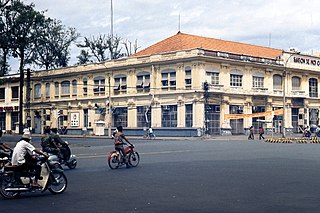
RMK-BRJ was an American construction consortium of four of the largest American companies, put together by the United States Navy during the Vietnam War. Its purpose was to build critically needed infrastructure in South Vietnam, so that the Americans could escalate the introduction of American combat troops and materiel into Vietnam. This construction contract, amounting to $1.9 billion, completed a construction program deemed to be the largest in history up to that time. The consortium derived its name from its four constituent companies: Raymond International, Morrison-Knudsen, Brown & Root, and J.A. Jones.

Naval Support Activity Danang or NSA Danang was a United States Navy logistics support organization located in Danang, South Vietnam active from October 1965 to April 1972.
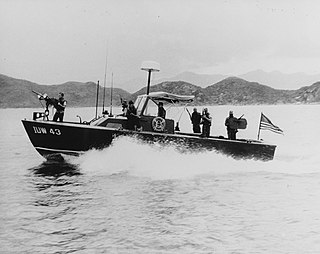
Operation Stable Door was the United States Navy and Royal Australian Navy's harbor defense operation during the Vietnam War. This operation complemented Operation Market Time designed to prevent infiltration along the South Vietnamese coast.

















